
In General
Technical
Lens Colors
Discussions:
Purple Lenses
Blue Lenses
RAILFAN GUIDES HOME
RAILROAD SIGNALS HOME
Background
Without lenses, we would not have signals.
Lenses perform several functions in the signal. They not only add color to the modern signal, but they also shape and/or focus the light beam.
Colors available for American railroad
signaling, past and present, are:
Green
Yellow
Lunar White
Red
White
Blue
Purple
You will notice that I put lunar white in between red and yellow. That is because in many of today's signals, you will find the railroads increasingly employing lunar white in signals as a way of further controlling trains in lieu of using a whole second head.
For more reading on the subject, here are some suggestions if you can still find them:
The Signal Engineer
magazine (goes way back to the beginning of the 1900's)
The 1908 and 1911
Signal Dictionary
Lenses developed over time. Production methods in the beginning were rather crude, and glass did not have the physical characteristics or coloring needed for railroad service when they were first developed.
The coloring of a lens is used to produce a specific color. While that statement may seem overly simplistic, it does not tell the whole story. The color of a lens will vary according to the light source, for the same color displayed. Incandescent light bulbs give off more red in their spectrum, kerosene lamps produce more yellow. Anyone going into a Home Depot or Lowe's, and goes to the light bulb section will see other terms such as warm white and cool white (terms related to the "temperature" of the light source). Looking at a (say) green lens for either of the two mentioned light sources will look different if held up to a sunlight sky.
As you read more and more about "color" you will notice that not all references use the same wavelengths for specifying the center frequencies and "edges" of various colors. This fact is noticeable in the color charts I have below.
Lenses today are specified by their chromacity, the
following diagram shows the allowable limits for each color.
Below in the floobydust section are guidelines on how
to read the chart.
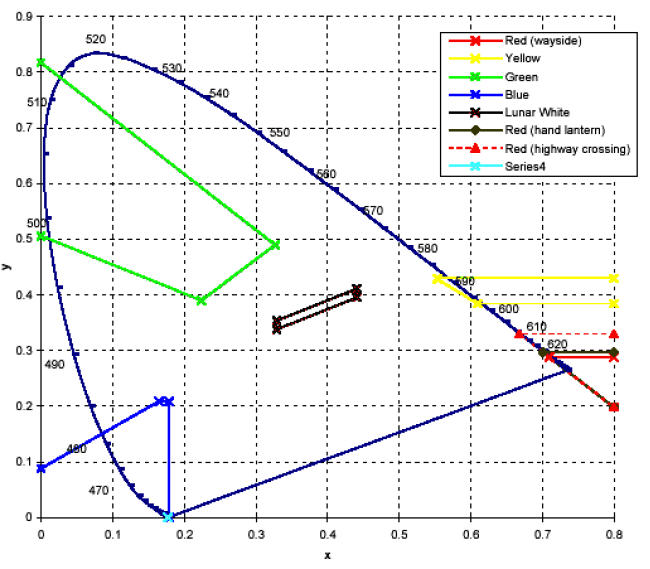
Below are a couple of charts to show you where the visible
spectrum of light sits in relation to other electromagnetic waves, including
radio and TV.
You will notice that the "edges" of the various colors vary according to who is
drawing the chart,
There are no hard fast accepted frequencies/wavelengths for the end of one color
and the beginning of the next,
Although there are generally accepted "center frequencies.
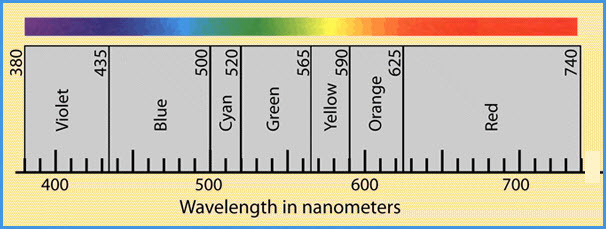
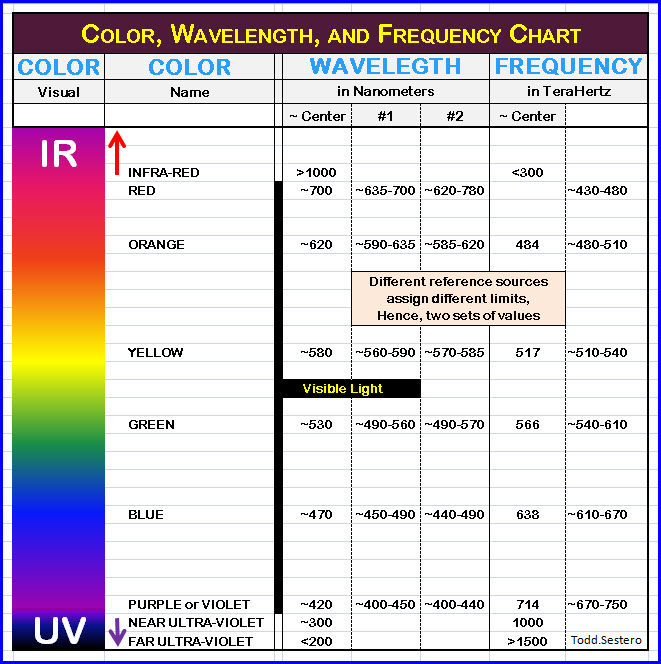
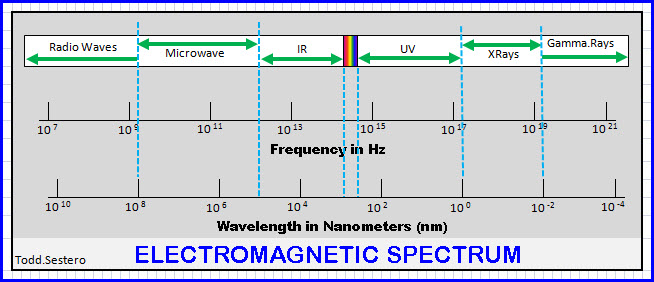

In earlier days, lenses were specified by their spectro-photometric values as shown in the Snags below. I need to point out that these numbers and references are made to light sources that used kerosene lamps, and not incandescent bulbs. Lenses used with kerosene lamps generally are different in hue (color or wavelength), due to the different wavelengths of light given off by each source. The problem with these specifications, is that are not definitive, in other words, they really don't get down to the business of specifying colors in a technical sense that chromacity does. They tell you instead, the transmissiveness of the lens at specific wavelengths. Terms like "extreme red" do not convey any real sense of a colors wavelength!
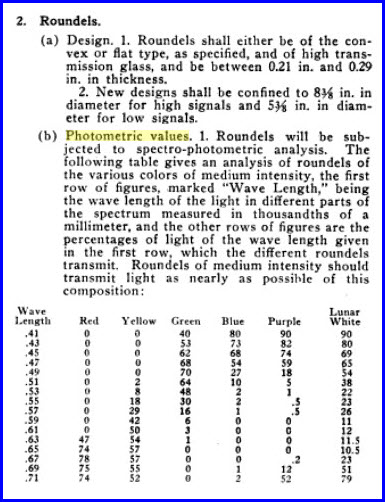
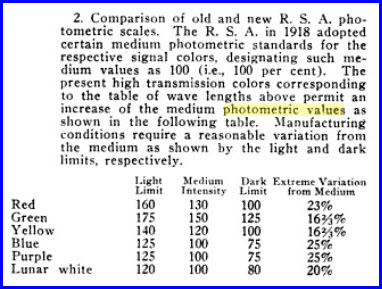
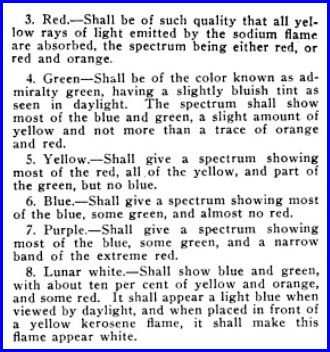
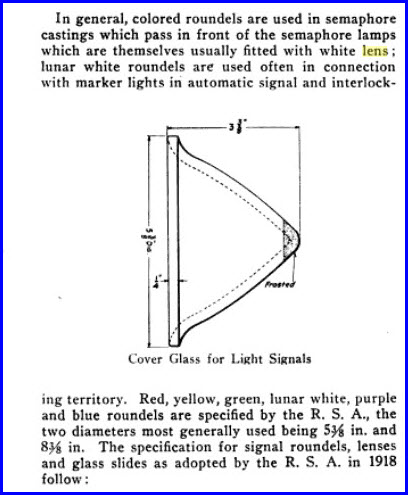
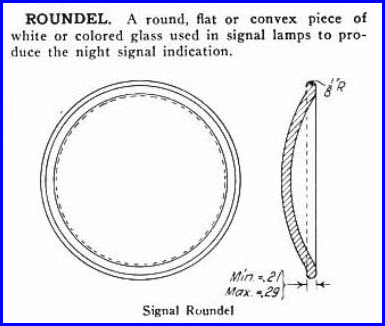
On the left, the lens pictured was only used on N&W and PRR
all yellow PL (Position Light) signals.
Green
Yellow
Lunar White
Red
White
Blue
Purple


(L) A dwarf N&W CPL signal (modified Pennsy style PL) with a green
aspect, from the collection of Eric Davis.
(R) Signal in Charlotte NC on the
Lynx light rail
system displaying a clear (with LED's).
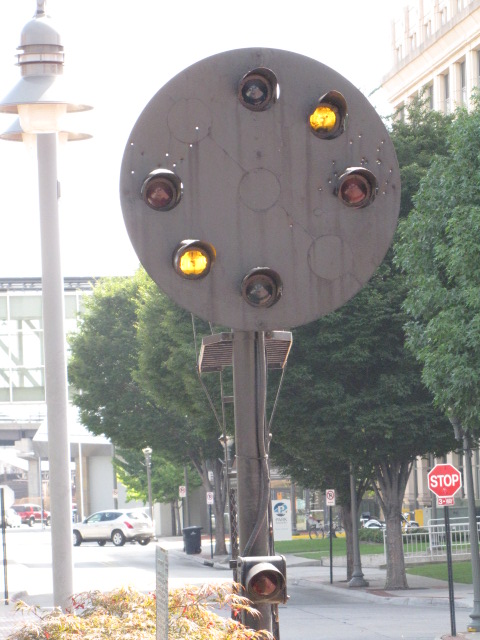
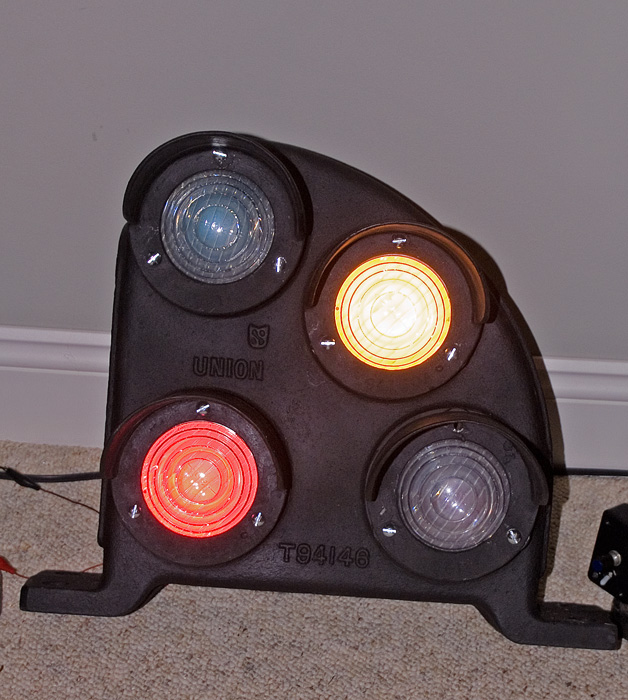
(L) An N&W style color position light signal in Roanoke VA, on the
Railwalk trail. Early N&W signals were all yellow like the Penny's.
(R) A dwarf N&W CPL signal with a yellow aspect, courtesy Eric
Davis.
Lunar white lenses, if looked at up to the sky, will have an ever so slight bluish tint to them. When placed in front of an incandescent light source, it will filter out some of the red wavelengths and give the resulting signal color an eerie white color, appropriately named for its similar look to that of a full moon.
Today, you will find lunar white in two places, but always for the same indication: RESTRICT.
B&O CPL signals used them on the backward 45 degree position. In modern signals, if employed along with the standard three colors, red, yellow and green, will (usually) show up between the red and yellow aspects.
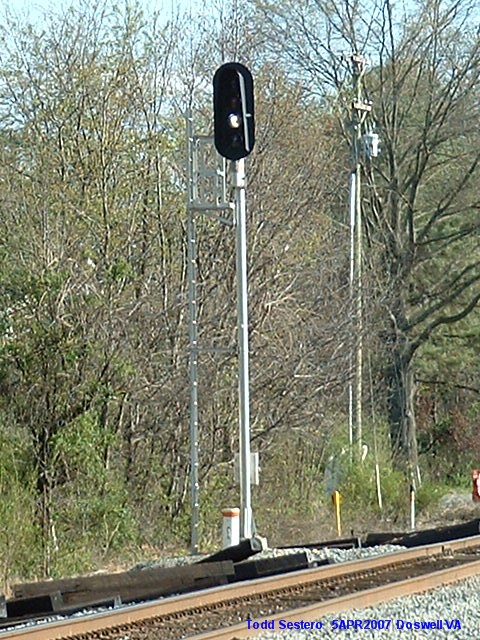
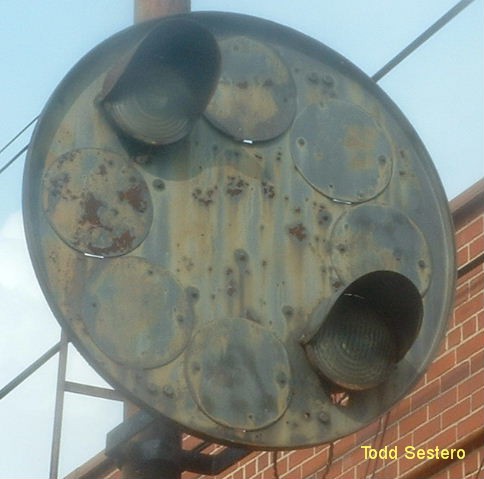
(L) A typical four aspect signal, with
lunar in the 2nd position up from the bottom. It is located at the diamond
in Doswell VA.
(R) Although not lit, this is a restrict only B&O CPL signal in
south Baltimore that uses lunar while lenses.

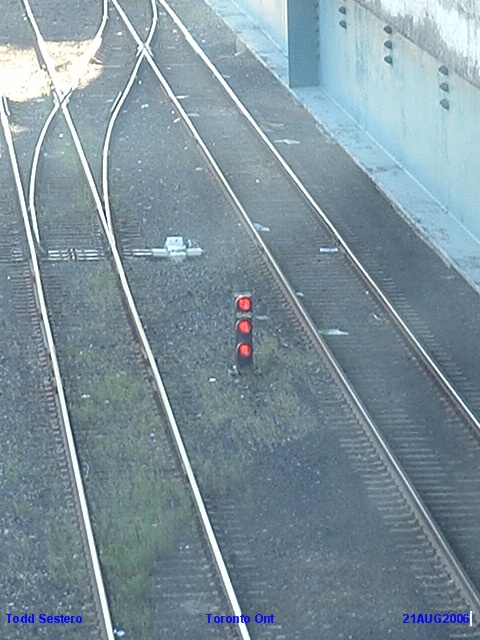
(L) Two "non-typical" red aspect signals. These are at the
throat to Union Station in Washington DC, and show you a red signal for the DC
Metro system (in the foreground), and a couple of dwarf CPL signals used on the
approach to Union Station. More pictures of the area are
here.
(R) A triple stack of searchlight signals in Toronto, all displaying red.
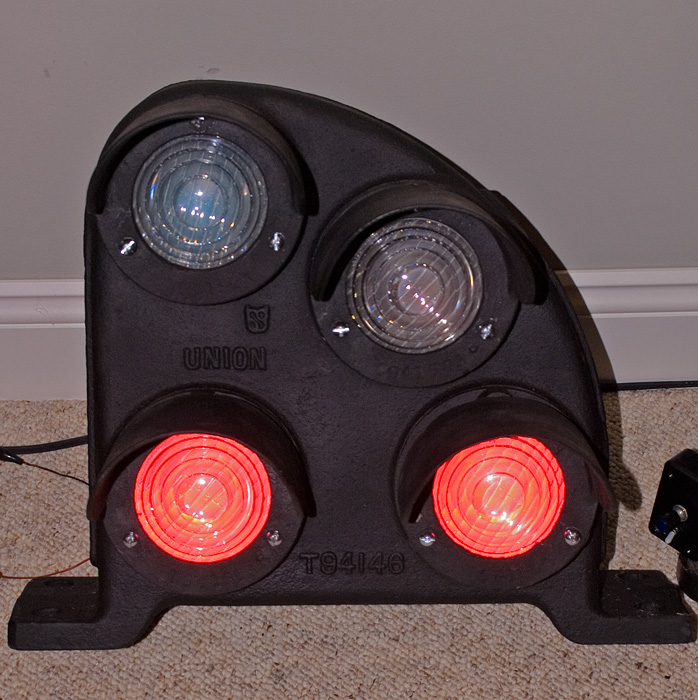

(L) The N&W dwarf signal again displaying stop.
(R) A simple B&O CPL signal in south Baltimore, with a stop
indication. The only other aspect this signal can display is restrict.
This signal was replaced by a color light signal around 2013 as part of an
upgrade project which saw about 10 CPL disappear.
White originally enjoyed being used as the original choice of color for displaying CLEAR. White started falling out of favor when the railroads discovered that when a red or yellow lenses broke and pieces fell out, the color as the engineer saw it was now white (or mostly so). So how was he supposed to be able to tell the difference between it and a viable clear aspect? If I remember the chatter elsewhere correctly (but don't hold me to it :-), most rulebooks had white removed from their rulebooks by 1915.
Today, white sees an increasingly smaller and smaller role in today's railroads. The only railroads still using white in a signal are those lines using the B&O style color position lights (seen below), where white is used as a marker lamp to modify the main colors, and those lines of the Pennsy where they used white in the Pedestal and dwarf PL signals - however, as those PL signals still around are switched over to LED bulb's, white is disappearing even more quickly, for they are using "cold white" LED's, which look more lunar than white.
White is also commonly used on transit systems, mostly subway/metro systems, where only red and white are used.
In Europe, white is often used in shunting signals found in yards. The signals are mostly dwarf signals, and use white and purple. The white aspect replaces green, and purple replaces red.


(L) White used as a B&O CPL marker lamp.
(R) White used in the middle of two red lenses on the Washington
DC Metro system, indicates proceed.
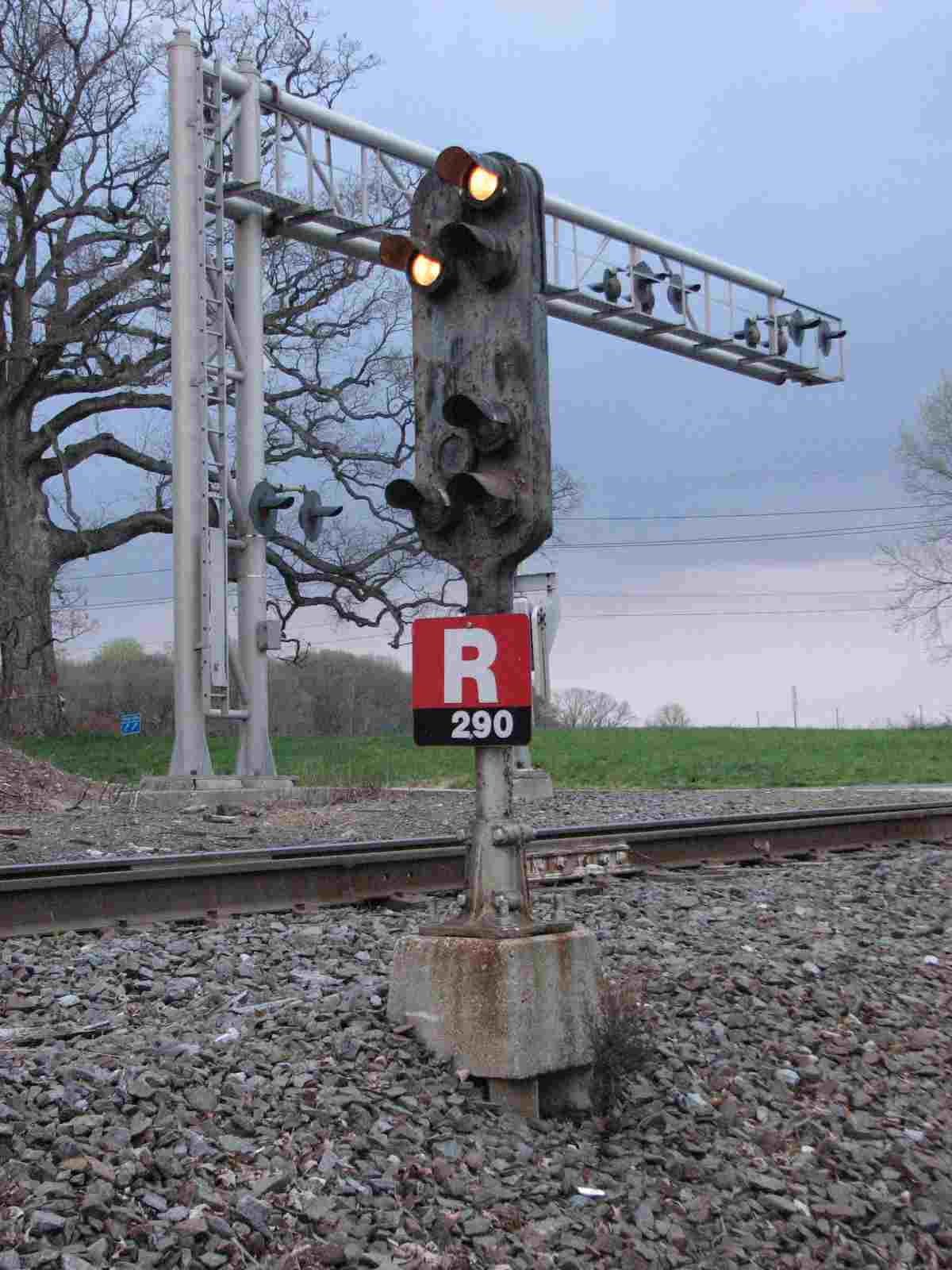
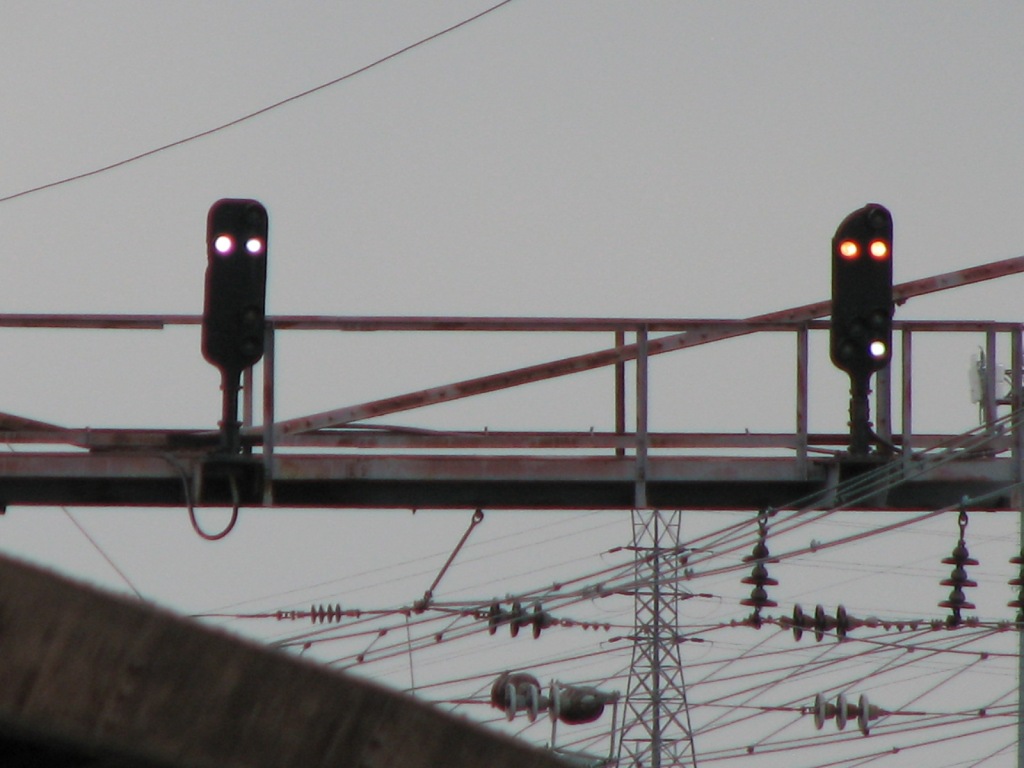
(L) A Pennsy Pedestal style signal in Newark DE, using all
white lenses.
(R) Pennsy Pedestal signals used above the NEC in Wilmington DE.
Notice the "whiter" ones are using LED bulbs.
Blue signals today are becoming increasingly rare. The main use of blue was for doll posts, indicating that a track intervened between the signal, and the track it controlled. The picture below does not do this color justice, for it does not truly show off the deep, rich hue of the blue color. If you ever see one in person, you will immediately fall in love with it. This signal was in Waltham MA, but is now gone. More pictures/info are here and here.
Blue is also used in shop areas to indicate that rolling stock, engines, LRV's, etc, are not to be moved because they are in the middle of having maintenance performed on them. This blue is much lighter in color than the lenses above, similar to Conrail blue.
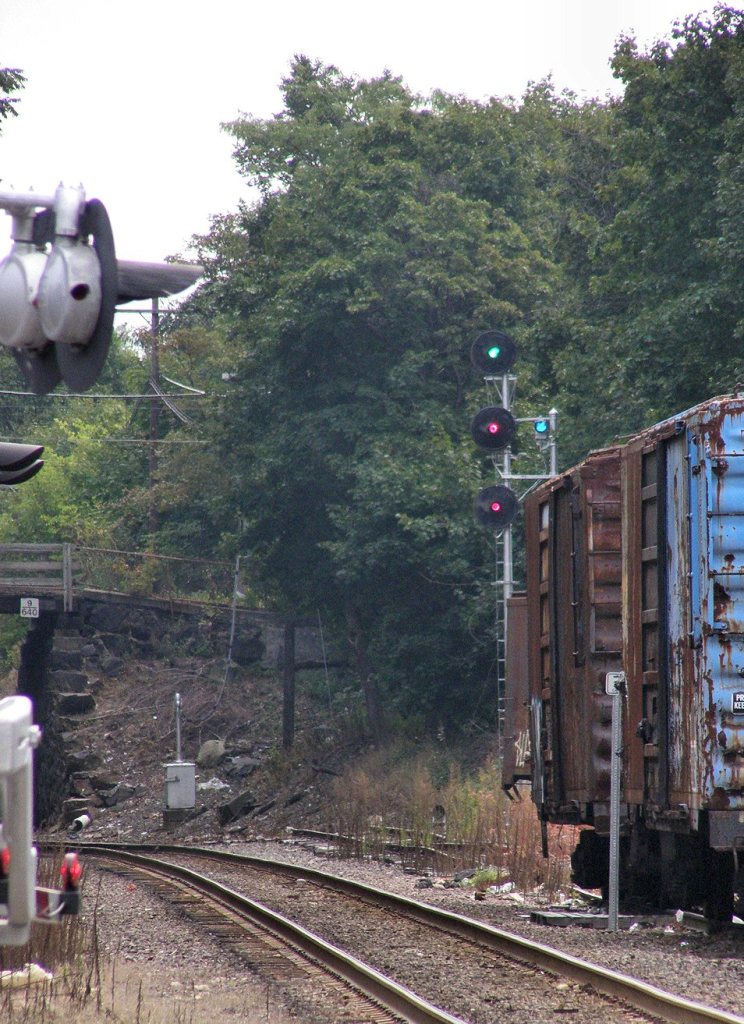
Please Note: Since the term is out there, and it is being used, either correctly or incorrectly, I feel it is necessary to bring up the usage of the term "cobalt blue". The term cobalt blue is used by many, to denote the rich deep blue color of these lenses, for when you look at it, or through it, it resembles that color. While perfectionists, historians, and rivet counters literally hate and are insulted by the term cobalt blue - it is with good reason that people such as antique dealers and many collectors call it this, as it nevertheless gives the layperson a way to differentiate the color from light blue, dark blue, sky blue (and at what point in the sky, as it changes dramatically as you go from the horizon to straight up, and at what time of the day!!!) or Conrail blue. If we leave it to the simple descriptive term of just blue, most of us will not have a clue as to the actual hue. True, when referring to blue lens in railroad circles, it only describes one color, but, anyone who wants to use the term cobalt blue is OK in my book..... For those of you who DO have a problem with it's mention here, please do not read any more of my pages, for they will just make you madder and madder with all of the technical inaccuracies like this that I present in order to be a complete source of information:-) Ya'll can thank Paul for this notice, since he sent me 6 rather angry emails about my use of Cobalt Blue.... and so it goes.
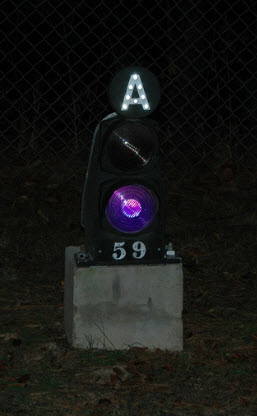
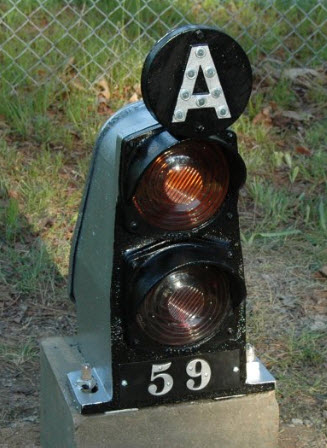
Purple railroad signals, since the majority of us have never seen them in service, invoke a sense of curiosity, amazement, and wondering.
Both purple and blue aspects are sought after by collectors, as they are a rare find.
Whenever "we" get onto the discussion of purple aspects, it is usually a long one, and one of the more interesting threads, as you will see below!
This page is more of a collection of discussions than a definitive technical and answer page, surrounding the use of purple lenses in railroad signals.
In the United States, purple saw use in signals up until, maybe, around 1940.
Most purple aspects were used in place of red, in fact, on some railroads, purple was the only color used for stop.
The picture at the top of this heading is of a signal in
the collection of Zachary C. Gillihan.
Much more very interesting, good stuff, and technical info can be found on
his website: www.RRSignalPix.com
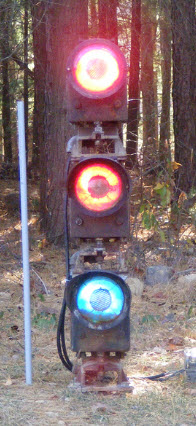
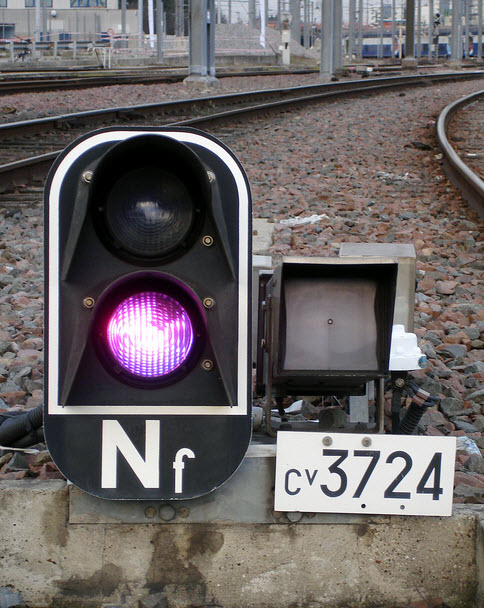
Above
left:
three
searchlight signals, with (from the top) Purple, Red, and Blue roundels.
Above right: A shunting signal in France, the top lens is white.... these
signals are found mostly in their yards.
More info is here:
https://fr.wikipedia.org/wiki/Carr%C3%A9_violet
Below, these pictures are excerpts from a New York Central 1937 rulebook, found at: https://railroadsignals.us/rulebooks/nyc37/nyc37.htm
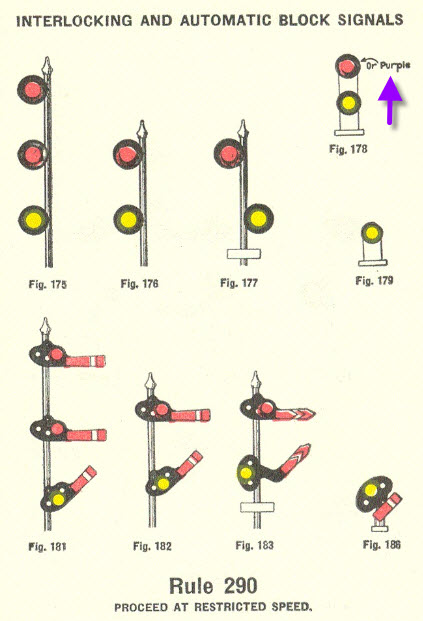
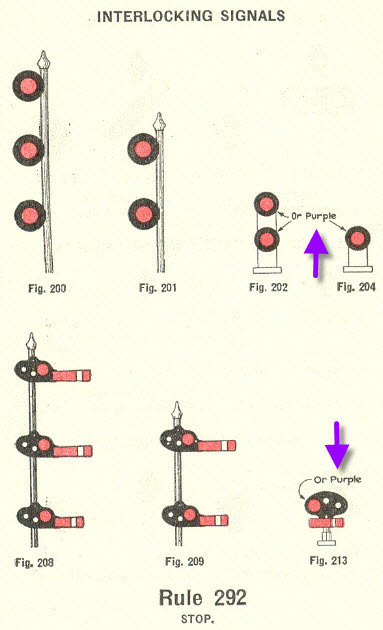
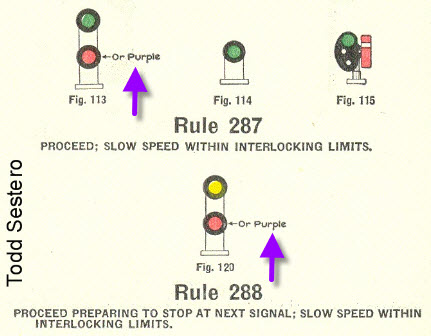
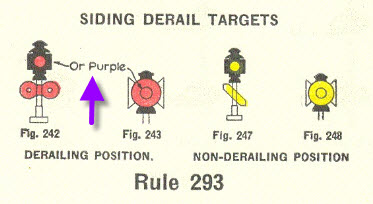
Discussions on Blue and Purple Lenses
The messages below come from the Yahoo Railway Signaling Group from early on, up to the thread of July 2013. Dates and message numbers included in case you want to dig into the message archive (if you're a member of the list).
4539 02/11/2003 I am wondering - has anybody on the list seen anything purple? Like lenses, roundels & such. I recently won 2 ebay auctions for 5" Corning roundels; their color was described as "black amethyst". They appear to be a very rich purple when you put light behind them (both electric light as well as flame light - I had to put a lighter behind it :) ). But they also chew up a lot of light. They are very dark. I'd say only 75% or less of the light from the lamp makes it through. Any thoughts on this?
4542 02/11/2003 Some info (and
trivia) on standard use of purple and blue lenses... so... leaving out
switch indicators... Blue lenses on signal heads are to mark dummy
units (doll masts) that mark a bracket mast signal (or such) to denote a
track between the mast and actual track governed (I've even seen 2 used to
mark 2 such tracks). Light blue lenses are what are used to generate
the lunar white (blue being the complement of yellow), and were/are used
with kerosene and electric lamps (in comparison to above, getting very
common in the US today on RR and transit). Blue is also used to mark
"blue light stations" or other emergency locations (generally a lamp, not a
signal). Blue is also used to "track blocking" and worker protection,
and can be found as a lamp or lantern (or on a control panel) to mark an
area that rail vehicles are prohibited from entering.
Purple was used as early as 1900 (perhaps earlier?) instead of Red for Stop,
but, I am only aware of it used in the US within yards or at derails.
Purple was typically used in US, circa 1900, for the backlight on semaphore
signals ("white" for other aspects).
A couple weeks ago while in Paris, I received a factual answer (finally) on
why purple was used for Stop in France on at least one rail line, rather
than their standard red... Well, it's a line with ATO where signals
mean nothing except when running in an ATO failed mode, and they didn't want
people to see the train going by a red signal - expecting that some people
would think it was wrong, so they made the Stop a purple aspect. I
never have learned why purple was used in the US for yards or derails.
And a new blue dummy is in place along the old C&A at "Stevens Station"
right next to Neck Road, Burlington, NJ for anyone wanting to see one... not
yet lit however, a couple months until lit... (awhile back people were
asking where these exist and could be viewed). (The
blue doll post signal is no longer, having been replaced by a cantilever
installation placing the signal directly over the track - Todd (2015))
4549 02/13/2003 Purple was used as
early as 1900 (perhaps earlier?) instead of Red for Stop, but I am only
aware of it used in the US within yards or at derails. Similar
practice exists in Europe. Traditionally, continental railroads
distinguish switching movements from normal train movements. One red
light is a stop signal for trains, but will be ignored by switching moves.
Blue or purple is used to stop switching moves. Two red lights,
"red-over-red" or like "snake eyes", is stop-and-stay for both. This
reduced the number of red lights for easier orientation of the train crews.
They will not be confused by the numerous dwarf signals needed only to guide
switching crews trough large interlockings. The reduced visibility
range of a purple light, due to the less effective generation of such
wavelengths in light bulbs, kerosene or propane flames, is still sufficient.
Note that purple, then blue are the fist colors to be absorbed by fog.
A couple weeks ago while in Paris, I received a factual answer (finally) on
why purple was used for Stop in France on at least one rail line. The
use of purple is even standard on all SNCF lines. A purple square
board or one purple light is called "Carré violet", being the stop-and-stay
signal for switching moves. When the purple board is removed, a white
(unfiltered) light is displayed, a switch crew might proceed at restricted
speed. However, a purple light can be ignored by train crews.
The OSShD (eastern block counterpart of the AAR) recommends blue for this
purpose. Poland and Czech Republic are using it, as far as I have
seen.
7968 01/07/2005 In France, purple was adopted to indicate the condition of the route for an ATC block where the train control follows the ATC, but not the signal (the opposite of US practice) - whereby if the signal fails to display for any reason it doesn't keep the train from moving so long as the safe train control vitals meet the requirements. At first glance it looks like Stop, and is called Stop, but, only means Stop to a human operating the train, and NOT stop when under full ATO (as signals don't mean anything cuz nobody is observing them). The same method of signal circuits/software is now in use in Puerto Rico (the first US system to do this to my knowledge). In Puerto Rico, the red was kept - but in France, they use purple so that when people see a train go by the purple signal, they don't think the train just ran a Stop - the only reason for the purple, to avoid the annoying bad perceptions of the public, etc.
11271 01/12/2007 Hi Bob, What diameter? Several were made...some used in switch stand lanterns took oddball sizes. I might have one in my box of lenses. You must know the purple was used for kerosene illuminated aspects and does not show same color with incandescent lamps. Makes kind of a ghoulish blue depending on wattage.
11275 01/12/2007 PRR used purple electric lamp signals, and almost certainly included US&S searchlights, although I never saw one - their standard about 1910 for slow speed signaling (generally yard type move) or governing over a derail. If the proper lamp is used and at the proper design voltage, it is purple. I can't help you with the purple for the H2, but have a 5 incher laying around... (PRR leftover)
12579 07/31/2007 Purple became the standard Stop Signal color for PRR for moves over derails (generally, think yards and slow speed entries, the reason this was generally only on dwarfs) before 1910 - it even made it into some position light dwarfs, so it would seem that this was still used in the 1950's - If you check the Safetran catalog, as of as recently as 2 years ago (don't have a newer one), these are still available (but, must buy a case). Blue lights and doll posts were generally only needed on bracket mast signals, somewhat rare today (at least in the northeast), so blues/dolls became rare too. I've only seen one that was on a standard mast (signal only 15-20 feet in the air, with blue light offset off the same mast - a position light signal with a the blue pl angel lens on Bordentown Br, in Trenton, NJ, retired about 1976). NJT recently retired the two blue lights installed on the River LINE in south Jersey on cantilevers (anyone that saw them can comment on why).
15650 11/04/2008 What railroad(s)
used purple in their searchlights? I am fairly certain the New York
Central did, have heard possibly the L&N. When did its usage end?
Also, the color of purple used to make the roundels for searchlights: was
that the same color of glass used to make kerosene purple lenses and
roundels?
I would certainly doubt the color of glass would be identical, given that
the two light sources (kerosene lamp vs. incandescent bulb) have
significantly different color properties.
15652 11/04/2008 I always wondered about that. A few years back, I bought a "purple" searchlight roundel, cone-shaped. Knowing that it is for an electric application, I expected it to appear more purple in color when I got it. Instead, its more of a kerosene purple (it does look purple with a flame behind it, I've tried it). I don't think I have ever seen anything truly electric purple, of if that color exists. Any thoughts on this dilemma? I have a standard-size glass color light signal lens in purple. I've actually installed it, a blue lens, and a lunar white lens in a three-unit dwarf signal I have just for fun. I would theorize that it and your searchlight roundel produce the same color given the same light source.
15653 11/04/2008 Standard size lens - you are speaking of a 5 1/2" diameter by 1/2" focal distance, or an inner doublet lens? If so, I have a couple of those. I do not have a blue to compare them to, but between the searchlight roundel and the inner doublet, they do produce the same color. Even at that, I would call them kerosene purple as opposed to electric purple. Put a flame behind them, they emit purple as I think purple would be. But with an incandescent lamp behind them, they seem blue to me. Was there ever an electric purple that transmitted a true purple, the same spectral purple transmitted by a kerosene flame through the lens? Or did kerosene purple remain the standard even with an incandescent light source even though it appears more blue than purple?
15656 11/04/2008 I am not the most knowledgeable about the color spectrum as such, but, would the purple (used with incandescent bulbs) have been an early attempt at lunar white (LW)? When did LW become in vogue as we know it?
15657 (in response to 15656) 11/04/2008
There was a discussion about this not too terribly long ago,
but some railroads used purple in lieu of red for the most restrictive
indication on dwarf signals. The philosophy was that it helped
enginemen distinguish a dwarf signal from a red lantern held by a brakeman,
as both would be close to the ground.
Some railroads (I believe MP, T&P, StL-SF, and KCS) even used the purple in
lieu of red on the bottom (call-on) arm of high signals.
I believe both practices were out of vogue by the late 1940s.
I believe lunar white made its debut in the mid-to-late 20's as the B&O
began to standardize on the color position light, but as far as I have
found, it was not commonly used for the call-on aspect on color lights until
the Sixties.
15666 11/04/2008 Still doesn't answer my question entirely. I know it is a very technical and pointed question - Is it proper, then, for a kerosene purple lens (be it searchlight or color light) to be used, as is, in an incandescent situation and still be called purple, even though there is a difference in its appearance due to a different light source?
15671 11/05/2008 To add to Jon's
comments about the use of the color purple, the Missouri Pacific St. Louis
Terminal Division issued Bulletin Order No. 92 on Oct. 28, 1940 that stated:
"Effective 12:01 P.M., October 30, 1940, the use of purple to display stop
indication of Dwarf Signals, Absolute Signals and Switch Target Derails,
will be discontinued. Purple will be replaced with Red in all signals
and derails where purple has been used."
The Missouri Pacific Sept. 1, 1929 rulebook shows purple being used on the
lowest head of three headed signals and on dwarf signals. An exception
was on color light automatic block signals that had a third head offset to
the left that used red. The Nov. 1, 1940 (UCOR) rulebook shows all
third heads with red.
15685 11/07/2008 I don't know if this
is relevant in terms of the use of purple as a discrete colour but in French
signalling practice "violet" (i.e. purple) is used as an absolute stop
signal on subsidiary lines mainly where freight yards or service tracks
enter main lines and sometimes where signal control reversing moves.
As a colour light signal it displays a single purple light and is known as a
carré violet (purple square) from its form as a mechanical signal. It
has the same meaning as a main line absolute stop signal (carré absolu)
which displays two red lights as a CLS and whose mechanical form is a square
divided into four quarters alternately red and white but because the lines
it applies to don't have trains operating at more than switching speeds it
doesn't need to be preceded by an advance signal.
I don't think purple has ever been much used as a discrete signal colour
anywhere else in Europe though the British LNWR did use it for a while in
the late nineteenth century for shunting (switching) signals in order to
reduce the number of red lights presented to drivers. I assume that
was also the reason the French adopted it and as both colours mean stop any
confusion between purple and red would not present a danger.
15690 11/07/2008 Actually, I think
that light blue is closer to lunar white. There was a great amount of
scientific research in the late 1890s and early 1900s as the potential
application of the new electric lights was given serious consideration by
railway signal engineers. Some of the most significant problems that
had to be overcome pertained to the production of colors such as lunar white
and amber. Production of colored glass requires the mixture of different
minerals and in order to produce a specific shade, the specific formula must
be determined and then followed in each production run.
The specific problem faced by the glass manufacturers was this: yellow falls
in the color spectrum between red and green. The task was to develop a
yellow glass color that eliminated even the slightest hues of red or green.
The same problem was presented with lunar white. It falls in between
white and blue in the color spectrum.
I believe that the reason that purple or violet was commonly used was that
it was significantly different enough from red, yet was easier for the glass
companies to produce in sufficient, consistent quality and quantity.
Even with improvements, some railroads such as the Nashville, Chattanooga
and St. Louis Railway persisted in using white lights for signals into the
1970s and 80s. The last white signals used on the NC&StL were the Dragging
Equipment detectors on Cumberland Mountain. Under NC&StL and L&N
operating rules, failure of the signal to display a flashing white light
indicated dragging equipment, requiring an inspection of the entire train.
15706 11/09/2008 According to the
Chappe Brothers research purple is the worst colour in fog (where yellow is
the best). Hence purple signal colours are only used if sighting
distance is NOT an issue as such.
France uses the purple most extensive (absolute stop "Carre Violet" on
SERVICE tracks only ("voie de service"). Only a white or white
flashing aspect can be shown at the position of the signal as well (to
indicate "proceed" or "proceed, but do not proceed beyond yard limits").
Purple was used in the Netherlands as shunting signal indicating absolute
stop for shunt movement in two types of signals (not in use since the 80's).
Italy used purple signals in the "marmottas" (little mechanical shunting
signals) to indicate "stop". Torino or Milano is a nice example.
Purple is used currently on the BLS Railway between Spiez - Frutigen -
Kandersteg - Loetschberg - Goppenstein - Brig as so called "SIM signals"
(SIM = Simplon Intermodal). A purple light indicates that a SIM train
must STOP at the signal irrespective from any other aspect shown at the same
position as the route is being set towards a track where the SIM train may
NOT run due to height/width restrictions. Any other train may pass the
purple light. The purple light is preceded by a flashing purple light.
The trick for the engineers is simple: if you have a SIM Train: you
shouldn't see anything purple! Any other train: ignore purply
thingies. As a back up the system uses "layout tables" and purple
signs to inform a SIM train engineer that he's heading towards a track NOT
suitable for SIM Trains. This in case the normal signal can't be
operated and the signal must be passed at stop with authorization.
There are a couple of more purple signals on the world. Blue has a
similar story :-)
15700 11/08/2008 I believe they also refer to them as shunting signals, like the Brits do.... the purple is hard to photograph... in most of the pix I took of these signals while in France, the purple didn't show up very well....
15712 11/11/2008 I've been following
the discussions on the use of purple lights in signals for a few days now,
and I'm just curious what time frame the NYC used purple in place of red in
dwarf signals.
I've lived my entire life in former NYC territory in Indiana, under Conrail
and CSX, and every single dwarf had the usual red, yellow, and green aspects
(except at CP IU in Indy, where they had a red light sandwiched between two
yellows to show either Slow Approach or Restricting, and at CP 246 in
Anderson they only had red and yellow).
Did NYC ever use purple signals on the Indianapolis Line, and if so, when
did they convert to red?
17189 05/09/2009 I am looking for a purple
lens that fits a color light signal. I have two signals that I think
are from Carrol Street Interlocking in St. Louis. I also have a PDF
that talks about the signals at Carrol Street Interlocking had Purple for
stop and yellow for Proceed-with-caution. Also does anyone know when
they stopped using purple at Carrol Street Interlocking? Here are two
photos of the signals I have:
No. 59
http://rrsignalpix.com/collect/Dsc_0051.jpg
No. 63
http://rrsignalpix.com/collect/Dsc_0061.jpg
17191 05/10/2009 Missouri Pacific RR operated the City of St. Louis owned Carroll St. Tower. Missouri Pacific Bulletin Order #92, dtd 10/28/1940 ceased the use of purple in signals on the Mopac. See message #15671 for the complete text.
22839 05/30/2012 Purple on the PRR was used at ground mounted derails, indicating derail in place. CE78(J) 1205a4 and 1411. Blue was Rule 26 and dummy signal mast - track intervening between mast and signal head.
If anyone feels so inclined to look up the entire chain of emails, the numbers in the following (extensive) thread reference the message number on the Yahoo Railway Signaling group from July 2013. Some of the comments/replies may be opinions or speculations, however, they all make for good reading. Comments in green are my own.
24469
I am reading an section from a 1940 US&S catalog.
Under the one-color style R-2 light signal unit it has listed below the
color lenses available for it.
Red, Yellow, Purple, Green, Lunar White. What would a purple aspect be
used for?
This is the question that sparked this really nice set of replies and comments concerning the use of purple aspects in railroad signaling, much more comprehensive than the last time we talked about purple!
24470 Dwarf aspects, indicated stop for many railroads. Helped sort between red switch lamps and dwarf signals. I have a purple in my dwarf MD.
24471 If I remember correctly the C&O yard in Peach Creek, WV used a purple dwarf signal on its thoroughfare track. I have no idea what it signified.
24472 Stop aspect on dwarf signals as Zach said, this was used many places, though the usage dwindled around the Forties. The idea was to have a fixed signal whose color was easily distinguishable from a flagman's red lantern. Elsewhere, a purple unit could be used as a doll arm, forming the placeholder when one or more tracks intervened between the signal mast and the track the signal governed. However, blue was also used by other railroads for the same purpose. A blue or purple reflector could be used as well.
24496 I've seen those AT&SF dwarfs with blue in
them. Very Very wild! Here is a photo of one I had:
http://www.flickr.com/photos/23430972@N04/7360336698/
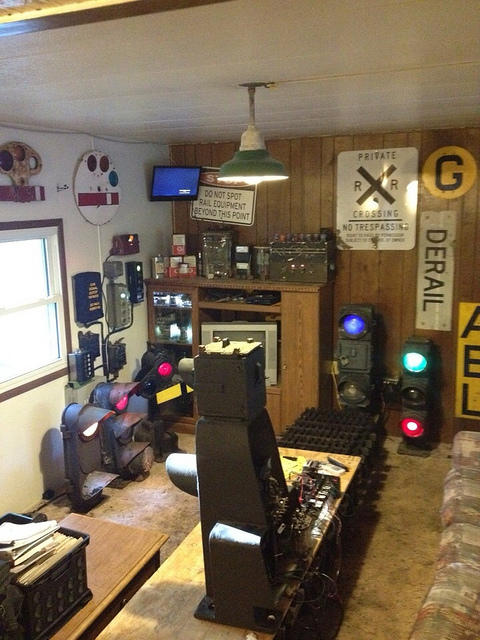
24473 Usually, to get Lunar White, you use a bluish purple lens. Strange that they have purple and Lunar White. (Actually, for lunar white with today's incandescent lamps, the lens is a very lightly colored blue lens).....
24478 So the purple means the sane thing as a lunar?
24481 Purple and Lunar White are two different aspects. They varied from railroad to railroad. Purple commonly meant stop indication on dwarf signals as Lunar White commonly meant Restricting.
24482 I have seen purple used for derails on the B&O.
24483 (in response to 24469) NO. It means the same thing as RED. The problem with purple is that it is a dark color. AFAIK it was only used in dwarf signals where the aspect is usually viewed at 100 ft or so. BLUE has the same trouble as purple, plus it is supposed to be used only to protect mechanical employees working on cars or engines. Well, you can't get away with plain white! Too many white lights all over the place, and if a roundel is broken out, it gives a white light. So they made a blue that was very light - only a hint of color, and it looks like the color of the moon. There WERE some pure white signal lights. PRR used milk white lenses in dwarf position light signals for example. You can get away with it on dwarf signals because you can see the body of the signal and tell what the aspect is, while a high signal aspect must be discernable at a mile or more.
24489 Interesting point and true. In some morning sun B&O books there are a couple of rare pics where you can see switch lamps equipped with purple day targets and I presume with a purple lens altho that was not discernable in the pic. I have only seen one true purple switch lamp day target that was (porcelain )purple. Not in the best condition but I think must be rare. It was not just painted over purple either.
24485 Here's another one, used by SNCF in France (pix below): http://www.flickr.com/photos/mark_vogel/2865219737/ The signal on the right is using purple and an Nf plate to indicate an absolute stop aspect. Why that signal uses purple, as opposed to the red indication that denotes the same aspect, I have no idea.
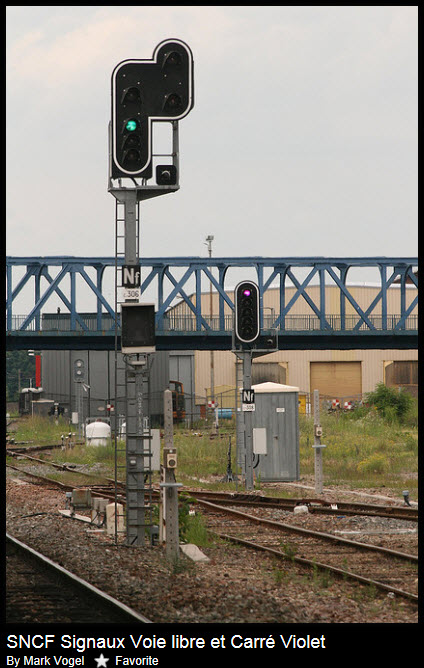
24486
The carré violet (in France)
is used on shunting/switching/service/subsidiary tracks, with the violet
(purple) being used to reduce the likelihood of confusion with full running
signals.
For example, see
http://www.carreweb.fr/stfr/sl_en.html
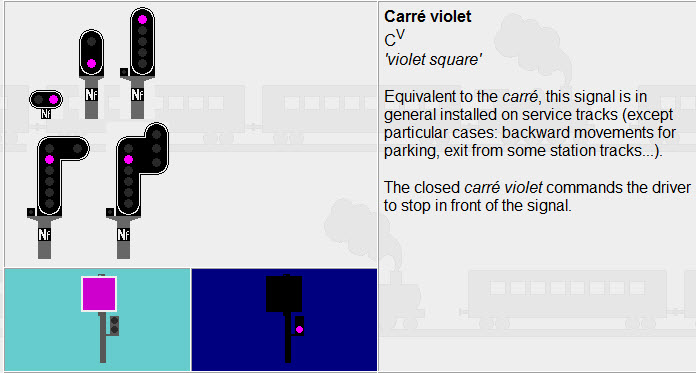
24488 As previously mentioned, purple was a fairly common color used for stop aspects in the days of steam. If you look in the old signal rules, it was most commonly used for the stop aspect on dwarf semaphores and derail markers on low speed routes. I seem to recall that it started to fall from favor in the 1920s but hung on for a while on some roads, much as white for the clear aspect did. Signal uniformity did not exist in large part until the ARA.
24490 There are several reasons that blue is a
poor choice of color for signals that need to be viewed at long range.
First, blue light has a higher frequency than red. This physical
property can also be expressed by saying that blue light is a shorter
wavelength than red. Light waves are subject to refraction (bending)
when they pass from one medium into another (such as when passing from air
into glass, or when passing from air into water).
Light waves striking a raindrop will refract upon entry (the first change of
medium the light permeates), as well as refracting further when the waves
again undergo a change of medium as they transit from within that raindrop
back into the atmosphere. I've described just one raindrop; since
raindrops seldom occur in solitary form, this effect is multiplied for every
surface transited by the light waves between light source and viewer.
Waves with higher frequency bend more on refraction, meaning that blue light
is more scattered as a result of these repeated passages from one medium to
another that come about as a result of rain, fog, snow, smoke, or mist.
Any attempt at focusing blue waves (using a signal lens, for example) is
largely destroyed by the effects of refraction when atmospheric conditions
are poor. In contrast, the light produced by a light of lower frequency,
such as those in the red and yellow portion of the spectrum, is not as
adversely affected by these atmospheric effects.
The different angles of refraction associated with various parts of the
spectrum are, incidentally, what brings us the phenomenon of the rainbow.
Furthermore, the vivid red and orange colors associated with sunrise and
sunset are also a result of refraction; because the sun's light passes
through more atmosphere at low angles relative to the horizon, more
refraction occurs. Because of the lower angle of refraction of colors at the
low frequency end of the spectrum (like red and orange), these colors are
dominant to a viewer on Earth gazing at the rising or setting sun.
An additional physical property weighing against the use of the color blue
in railway signaling is that the human eye has fewer photoreceptor cells
sensitive to blue light. Though this is an oversimplification of a
complex subject, nearly two thirds of the eye's cone cells (photoreceptors)
are sensitive to high wavelength (low frequency) light such as reds and
yellows, while only 2% of the eye's photoreceptors tend to detect short
wavelength (high frequency) light like blues. The fact that there are
three kinds of photoreceptor cone cells in the human eye is why we tend to
think in trichromatic form e.g., in terms of describing colors as being
mixes of reds, greens, and blues.
One further factor that tends to weigh against the use of blue in railway
signaling is that the light emitted by an incandescent light source does not
contain a great deal of light in the blue portion of the spectrum. This
means that, once the other parts of the spectrum are filtered out by the
blue lens, there is precious little blue left to be transmitted through the
atmosphere to its viewers.
To sum up, only a tiny amount blue light is produced at the source, and
there is even less of that blue light available once the atmosphere has had
its hand in causing refraction of that light and even then, the human eye is
not particularly sensitive to the blue light that does reach it in spite of
these handicaps in transmission.
The Pennsylvania Railroad and Corning Glass performed groundbreaking
experiments with the transmissive properties of light in a collaboration
between the PRR's chief signal engineer A. H. Rudd, and Dr. William
Churchill of Corning in the 1910s. The result was the position light
signal, with the particular yellow color being chosen because it had a low
angle of refraction and was therefore distinct in poor atmospheric
conditions, such as the fog and smoke associated with much of the PRR's main
routes through the industrial belt of the eastern seaboard and along the
waterways through the Allegheny mountains. The color used much of the
spectrum produced by the incandescent bulb, meaning that the bulb could be
burned at a lower voltage for longer life and more efficient power use.
And finally, the part of the spectrum produced by the position light's lens
is one for which the human eye's photoreceptors are particularly well
suited. The PRR, of course, used white light for its dwarf signals,
which were not intended to be viewed from long distance.
These various reasons indicate why blue (and purple) have long tended to be
limited to short-range purposes in railway signaling, such as the Stop
aspect on a dwarf signal, to mark doll arms as placeholders, and to provide
protection for employees working on, under, or between equipment (the
so-called "blue flag" rule).
24491 I have seen purple used on dummy masts and doll signals on some railroads in the past (NPRY in this case). You usually find them on signal bridges, with the doll signals or dummies mounted over tracks that really are not signaled at all. Their purpose is to keep train and enginemen correctly oriented vis a vis signals mounted directly over a number of tracks where one of the tracks is a yard track or industrial spur or some other non signaled track. Their use has kind of fallen out of favor in more recent years. Also purple is in a spot on the color spectrum that is not really easy to see from a distance.
24492 Blue is difficult to see and focus on. The same may be true of purple.
A house near mine was outlined one Christmas entirely with dark blue lights. The corners, roof, eaves, everything had strings of blue lights. It caused a weird feeling to look at that house. I could not tell where to look, and could not focus on the lights.
24494
Interesting discussion here dealing on the use of
the "Purple" roundel in the H type searchlights. I have one of these
roundels, got it a few years ago from the now-defunct railroad signal
salvage firm of Bronson and Randall out of North Hollywood. First time
ever seeing one of these. Never saw one in use, however some of the
searchlights that Santa Fe had in Bakersfield, at the west end of the yard
at Jastro Junction had lunar white aspects on two of them. About 30
years ago I had obtained a couple of HC9's from a salvage operator working
with Southern Pacific. When I opened the back of
them, I was expecting amber lenses-only to find these cornflower-lavender
colored glass doublets inside the both. I hooked a transformer to them and
from each emanated almost pure white light-like that from the LED's you see
today. I was later told that the reason for this is because the
brightest light during the day will by characteristics show yellow compared
to the sunlight, so all the yellow rays of the incandescent lamp had to be
filtered out- and somehow this color of lens does just that. At night,
if say just a clear lens was used-and especially on a high signal, it may be
mistaken for a train headlight. But as for the "Purple" lens - this
for the same reason will in the daylight give off cobalt blue light, when
lit.
I noticed all these blue lights around the locomotive service facility on a trip I took with a friend one evening to Barstow. The people there told us that the blue aspect was like a "superior red" aspect in that when there is personnel working around the equipment, or fueling of units being conducted, nothing is to be moved without clearance from the shop supervisor, or road foreman of locomotives, etc. So this is why in this case they have these "cobalt blue" signals.
When I went to convert my HC9's to this "Blue", Glen Grant over at General Signals told me I would have to purchase the "Purple" lens for this. More mud in the water-I've heard of, but never seen, a searchlight roundel that is half red, and half cobalt blue-and when lit gives off (supposedly) a magenta light. Cannot for the life of me imagine where or why that would be used. But like everything else-Anything's possible. Hope this helps
24508 I can't put my hands on the appropriate rulebook, but the ICG had purple high signals. If I remember, they were used to indicate the end of signaled track.
24509 Terry, These were Rule 291-A, Entering Non-Signal Territory, with aspects of red/purple, red/purple/red, and red/red/purple. I believe these were instituted with the ICG rule book of July 1, 1974 and removed with the subsequent replacement book of rules.
24510 What you experienced is called Purkinje Shift, named after the Czech anatomist who discovered it. If you refer back a few messages to a dissertation by member John Roma it will be clear as to how your eye perceives color and brightness. These reactions are also called "glare" and "dazzle". Back to signals: purple has been used for hot box detectors in that a sudden red would indicate an emergency stop if the detector went off. Purple indicated a controlled stop. Also I understand that Erie used Purple/amber dwarf semaphores for their yards in New York.
24511 I experienced the same effect 50+ years ago in the Boston subway. There were occasional blue lights on the tunnel walls that gave the same weird sensation.
24512 A friend of mine has an interesting purple inner doublet type glass lens that fit the GRS type F and FA colorlight signals, cant recall due to memory loss/age what size these accepted internally. The outer clear lenses were 5 inch, and I think the internal lenses were 4-5/8 inch....maybe someone can correct me. But this particular one had the center optics cut out and had been replaced with magenta color glass in the bulls eye center leaving purple around only the perimeter. That is one of the strangest lens I've ever seen and we were curious what it was used for and what signal dept would go to all that trouble for one lens. It looked to have been done very professionally, maybe by Kopp or Corning. I have never seen another dual color lens like it and no he would not part with it....lol.
24513 My 1970 IC Rulebook shows Purple used on a Doll Post as a placeholder.
Reading The C.I.E. Chromaticity Diagram
Here are additional sources of reference:
http://www.mat.univie.ac.at/~kriegl/Skripten/CG/node9.html
http://en.wikipedia.org/wiki/CIE_1931_color_space
http://en.wikipedia.org/wiki/Chromaticity
Beware: If used as a source, ANYTHING from Wikipedia must be treated as
being possibly being inaccurate, wrong, or not true.
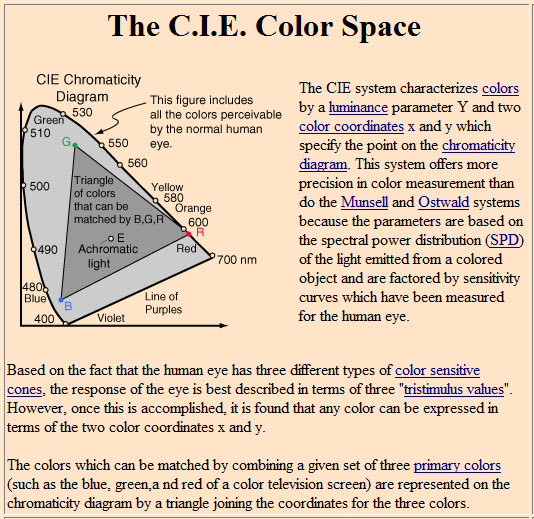 Found at:
http://hyperphysics.phy-astr.gsu.edu/hbase/vision/cie.html
Found at:
http://hyperphysics.phy-astr.gsu.edu/hbase/vision/cie.html
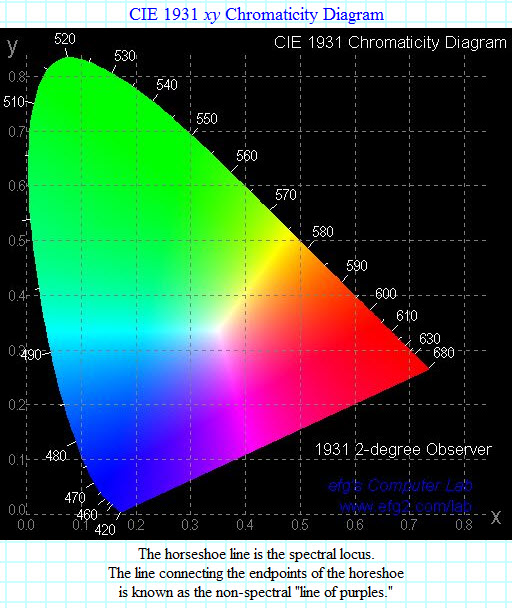 Found at:
http://www.efg2.com/Lab/Graphics/Colors/Chromaticity.htm
Found at:
http://www.efg2.com/Lab/Graphics/Colors/Chromaticity.htm
Disclaimers:
I love trains, and I love signals. I am not an expert. My webpages reflect what I find on the topic of the page. This is something I have fun with while trying to help others. My webpages are an attempt at putting everything I can find of the subject in one convenient place. There are plenty of other good websites to help me in this effort, and they are listed in my links section on my indexa page, or as needed on individual pages. Please do not write to me about something that may be incorrect, and then hound the heck out of me if I do not respond to you in the manner you would like. I operate on the "Golden Rule Principle", and if you are not familiar with it, please acquaint yourself with how to treat people by reading Mathew 7:12 (among others, the principle exists in almost every religion). If you contact me (like some do, hi Paul) and try to make it a "non-fun" thing and start with the name calling, your name will go into my spambox list! :-)
If this is a railfan page, every effort has been made to make sure that the information contained on this map and in this railfan guide is correct. Once in a while, an error may creep in, especially if restaurants or gas stations open, close, or change names. Most of my maps are a result of personal observation after visiting these locations. I have always felt that a picture is worth a thousand words", and I feel annotated maps such as the ones I work up do the same justice for the railfan over a simple text description of the area. Since the main focus of my website is railroad signals, the railfan guides are oriented towards the signal fan being able to locate them. Since most of us railheads don't have just trains as a hobby, I have also tried to point out where other interesting sites of the area are.... things like fire stations, neat bridges, or other significant historical or geographical feature. While some may feel they shouldn't be included, these other things tend to make MY trips a lot more interesting.... stuff like where the C&O Canal has a bridge going over a river (the Monocacy Aqueduct) between Point of Rocks and Gaithersburg MD, it's way cool to realize this bridge to support a water "road" over a river was built in the 1830's!!! Beware: If used as a source, ANYTHING from Wikipedia must be treated as being possibly being inaccurate, wrong, or not true.
My philosophy: Pictures and maps are worth a
thousand words, especially for railfanning. Text descriptions only
get you so far, especially if you get lost or disoriented. Take
along good maps.... a GPS is OK to get somewhere, but maps are still
better if you get lost! I belong to AAA, which allows you to get
local maps for free when you visit the local branches. ADC puts
out a nice series of county maps for the Washington DC area, but their
state maps do not have the railroads on them. If you can find em,
I like the National Geographic map book of the U.S..... good, clear, and
concise graphics, and they do a really good job of showing you where
tourist type attractions are, although they too lack the railroads.
Other notes about specific areas will show up on that page if known.
Pictures and additional information is always needed if anyone feels
inclined to take 'em, send 'em, and share 'em, or if you have
something to add or correct.... credit is always given! BE NICE!!! Contact info
is here
Beware: If used as a source, ANYTHING from Wikipedia must be treated as being possibly being inaccurate, wrong, or not true.
RAILFAN GUIDES HOME
RAILROAD SIGNALS HOME
NEW 07/27/2013,
11/04/2015
Last Modified
14-Feb-2019